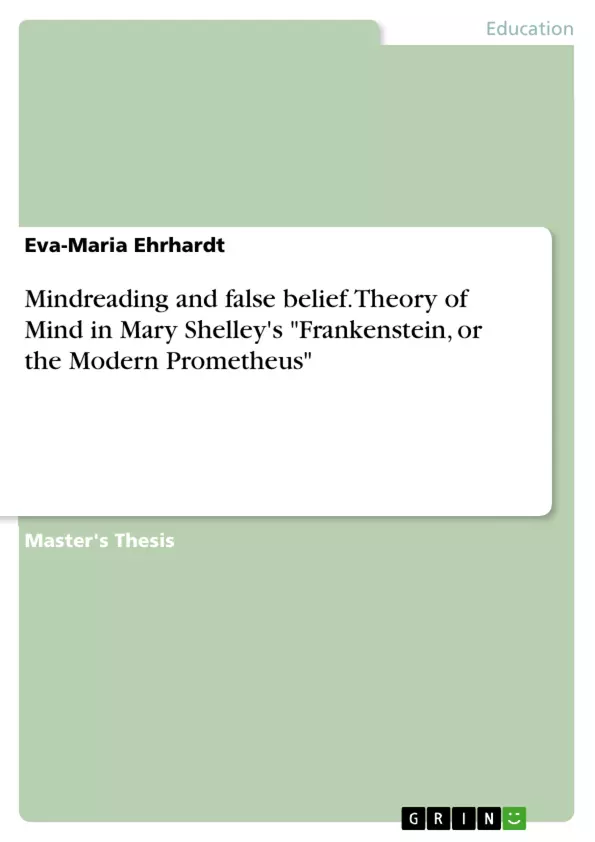Every reader who has spent some time with an infant has experienced the following scenario at least once: you are playing hide-and-seek with the child and, out of the blue, the child covers her eyes with her hands, believing to have found the most amazing hiding place. For the child, it is clear: he or she cannot see the adult, thus, the adult cannot see him/ her. In fact, the child is probably sitting in the middle of the room, without any object covering him/ her (except for the hands), and with the adult standing right in front of the child. This example is the perfect introduction to the topic of the present master thesis. The child is not yet able to understand that the adult is capable of seeing, believing or knowing something other than that which the child can. Or, in other words, the child does not understand that the adult has another mental state than its own. Thus, the child does not have a Theory of Mind, yet.
This master thesis deals with instances of Theory of Mind (such as the reading of minds, prediction of future actions, false and true beliefs) in Mary Shelley's famous work Frankenstein, or the Modern Prometheus (1818). The term Theory of mind (abbreviated as ToM) was introduced in 1978 by psychologists David Premack and Guy Woodruff in their famous paper “Does the Chimpanzee have a Theory of Mind?”. ToM denotes the ability of an individual to have a certain self-awareness, that is to be aware of one's own mental state, one's own beliefs (also false beliefs) but furthermore, the individual has to be able to attribute a mental state not only to themselves but to another individual as well. Given these conditions, the literature would suggest that this person has a Theory of Mind. I will discuss Theory of Mind in more detail in the second chapter. Besides Theory of Mind, there are also other terms that can be found in the literature, such as folk psychology, mindreading, mentalizing or even social cognition. [...]
Inhaltsverzeichnis (Table of Contents)
- 1. Introduction
- 2. Theories and Ontogenesis of Theory of Mind
- 3. Theory of Mind prerequisites in Mary Shelley's Frankenstein, or the Modern Prometheus
- 3.1 Self-awareness of Dr. Frankenstein and the Monster
- 3.2 Language ability of the Monster
- 3.3 Executive functioning
- 4. Theory of Mind: Mindreading and (false) Belief in Frankenstein, or the Modern Prometheus
- 4.1 Mindreading and False Belief of the Monster and Frankenstein
- 4.2 Dr. Frankenstein and Deception
- 4.3 Other humans and ToM
- 5. Empathy (and Love) in Mary Shelley's Frankenstein, or the Modern Prometheus
- 6. ToM and Descriptions of Nature in Frankenstein, or the Modern Prometheus
Zielsetzung und Themenschwerpunkte (Objectives and Key Themes)
This master thesis examines instances of Theory of Mind (ToM) in Mary Shelley's Frankenstein, or the Modern Prometheus (1818). The research focuses on analyzing how the characters' actions and interactions are influenced by their understanding of mental states, particularly mindreading and false belief. The study explores the development of ToM in both Dr. Frankenstein and the Monster, analyzing their abilities in terms of self-awareness, language, and executive functioning.
- The development of Theory of Mind in individuals, specifically within the context of Mary Shelley's Frankenstein
- Mindreading and false belief as key aspects of ToM in the novel
- The relationship between ToM, empathy, and human interaction
- The role of language and self-awareness in the development of ToM
- The potential influence of ToM on descriptions of nature in the novel
Zusammenfassung der Kapitel (Chapter Summaries)
The first chapter introduces the concept of Theory of Mind and its relevance to the study of Frankenstein. It uses the example of a child playing hide-and-seek to illustrate the basic principles of ToM. The chapter then discusses the historical development of ToM research and its significance in understanding human social interactions.
Chapter two delves into the theoretical foundations of ToM and explores its ontogenetic development. It examines various theories explaining how children acquire the ability to understand mental states, such as the Theory-Theory and the Simulation Theory. The chapter also discusses different research methods employed to study ToM, particularly the false-belief task.
Chapter three analyzes the prerequisites for ToM in Frankenstein, focusing on the characters of Dr. Frankenstein and the Monster. It examines their levels of self-awareness, language ability, and executive functioning, assessing how these factors influence their ability to understand and attribute mental states to others.
Chapter four explores the manifestation of mindreading and false belief in Frankenstein. It examines how the characters' actions and interactions are influenced by their understanding of each other's mental states. The chapter explores how both Dr. Frankenstein and the Monster engage in deception and manipulate each other's perceptions.
Chapter five investigates the role of empathy and love in Frankenstein. It examines how the characters' capacity for empathy and love, or lack thereof, influences their understanding of each other's mental states and their ability to connect on an emotional level.
Chapter six analyzes the relationship between ToM and descriptions of nature in Frankenstein. It explores how the characters' understanding of their own and others' mental states influences their perception of the natural world and how this perception is reflected in the novel's language and imagery.
Schlüsselwörter (Keywords)
The primary keywords and focus topics of this master thesis include: Theory of Mind, mindreading, false belief, empathy, language, self-awareness, executive functioning, social cognition, Frankenstein, Mary Shelley, literary analysis, and psychological perspectives.
- Quote paper
- Eva-Maria Ehrhardt (Author), 2015, Mindreading and false belief. Theory of Mind in Mary Shelley's "Frankenstein, or the Modern Prometheus", Munich, GRIN Verlag, https://www.grin.com/document/339891



